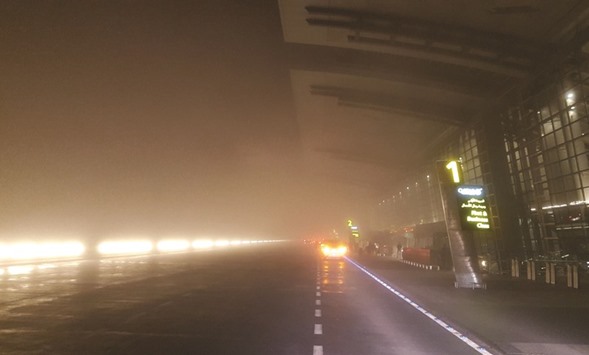The dense fog that blanketed Doha and other parts of Qatar during the afternoon earlier this week was caused by a phenomenon that happened once in two-three years, a senior official said yesterday.
Besides the morning and evening, thick fog was seen in Doha and other places even in the afternoon on some occasions since the start of the foggy spell on Sunday.
Abdullah Mohamed al-Mannai, director of the Meteorology Department at the Civil Aviation Authority, told the official Qatar News Agency (QNA) that it was highly likely that January would witness similar fog formations, although these would not be as intense as the recent ones.
The coming days, though, will see an improvement, he noted.
The Met department, too, tweeted yesterday that ‘settled weather’ is expected during the weekend, signalling an end to the foggy spell experienced in the country since Sunday. The conditions resulted in a sharp drop in visibility at a number of places, leading to slow movement of vehicles and prompting the authorities to issue safe-driving tips.
Explaining the intense fog, al-Mannai told QNA that it was the outcome of conditions involving a high-pressure area, easterly winds and lower temperatures. The combination led to increased humidity at sea and on the shore, which eventually caused the fog. He noted that December and January are the two months that see the maximum fog formation, particularly late at night and early in the morning.
As for the fog formation in the afternoon, al-Mannai said it’s a phenomenon that takes place once every two to three years and is referred to as the ‘marine layer’.
Asked if Qatar will witness a cold wave in the coming period, the official said this is unlikely. He explained that temperatures will drop in the coming days, but not to the levels where it can be described as a cold wave.
Al-Mannai also forecast that humidity will increase in January, noting that this is always the case in winter. However, the lower temperatures will ease the effects of the higher humidity levels, he observed.
On driving safely in foggy weather, he said the Met department and Ministry of Interior co-operated in issuing guidelines on how to do so. These include using low-beam lights, maintaining adequate distance, reducing the speed and using the wipers.
Yesterday, meanwhile, traffic was slow on many roads in the early hours as Qatar experienced another foggy morning. “Widespread” fog was reported from most parts of the country early in the morning along with zero visibility at times, according to the Met department.
The situation improved gradually and, unlike the previous days, the fog did not return in the evening in places like Doha.
Besides affecting road traffic and the movement of luxury boats, the foggy conditions also forced some fishermen not to venture out in the early hours, Gulf Times learnt. “No activity has been possible early in the morning in the past few days,” said a veteran fisherman in Al Khor.
Today, strong winds and high seas are expected in some offshore areas. The wind speed may reach a high of 22 knots at times, with the sea level rising to 7ft.
A minimum temperature of 14C is expected in Abu Samra today, while in Doha it will be 19C.
Global warming effect
Abdullah Mohamed al-Mannai, director of the Meteorology Department, yesterday told QNA that global warming has impacted the change witnessed in Qatar’s weather this year. He noted that industrial advancements and reliance on fossil fuels such as coal have increased carbon dioxide levels and ultimately led to a rise in temperatures.

Fog outside the Hamad International Airport departures terminal around Tuesday midnight: PICTURE: Bonnie James

